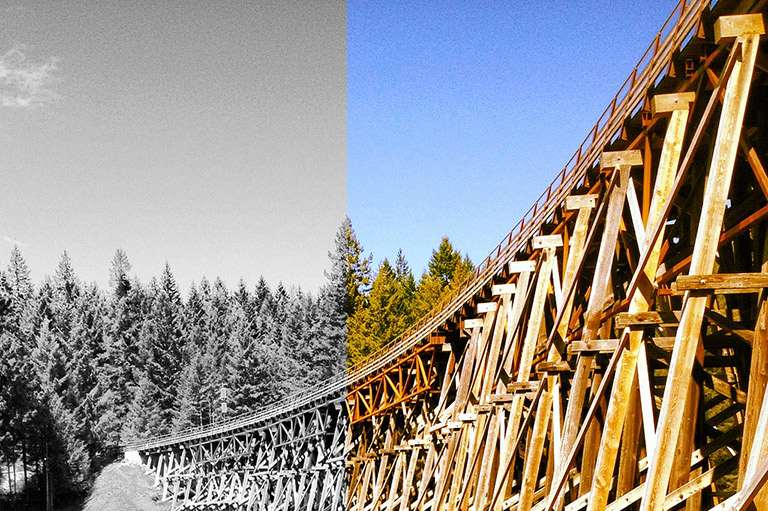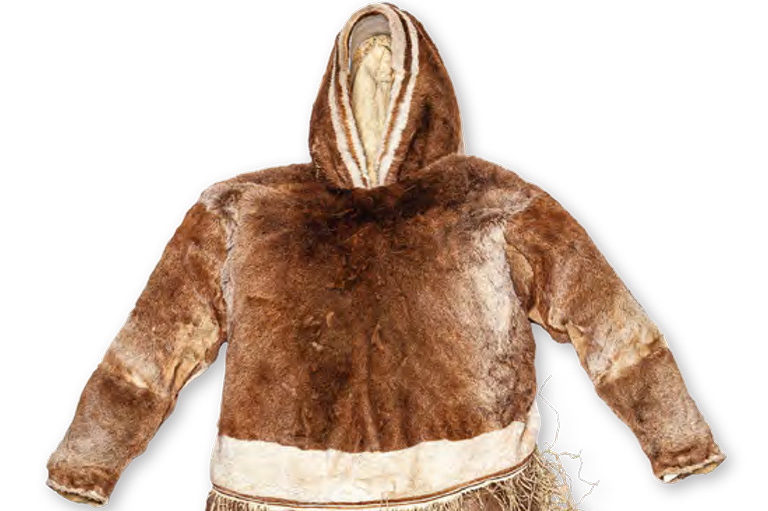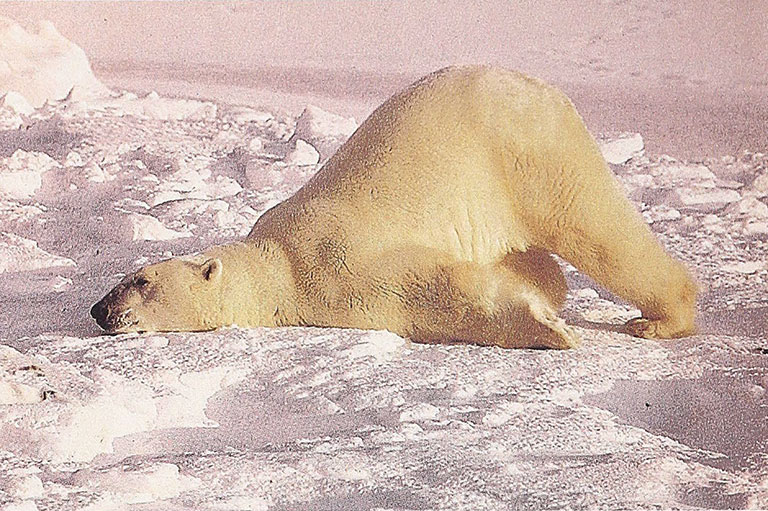Canada's Coldest Day
-
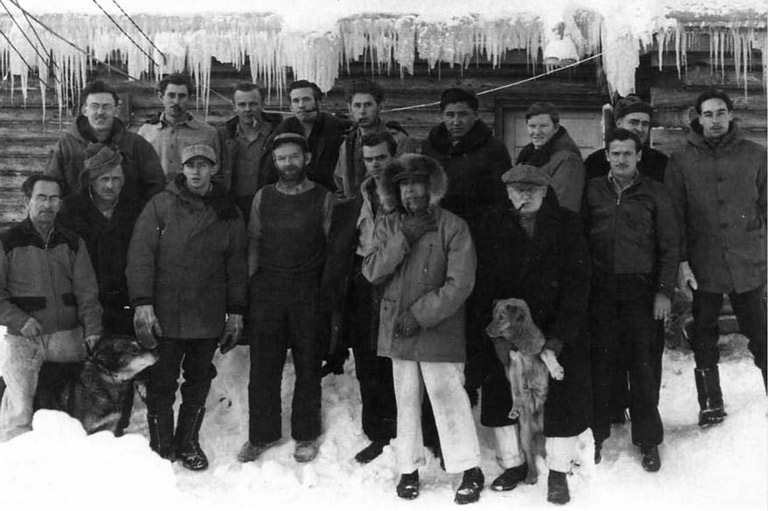 A group of Snag residents defy the elements, February 1947. The first three men in back row, from left, are Max Bowitz, Gordon Toole, and Wilf Blezard.
A group of Snag residents defy the elements, February 1947. The first three men in back row, from left, are Max Bowitz, Gordon Toole, and Wilf Blezard. -
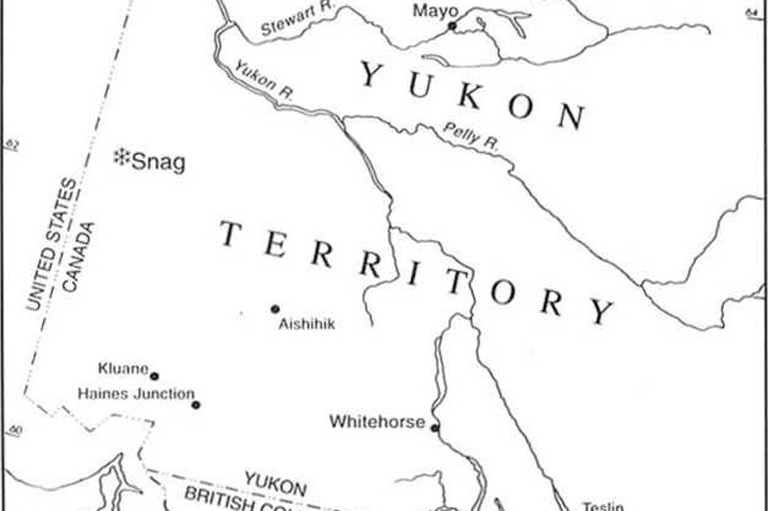 Map of area where Snag is located.
Map of area where Snag is located. -
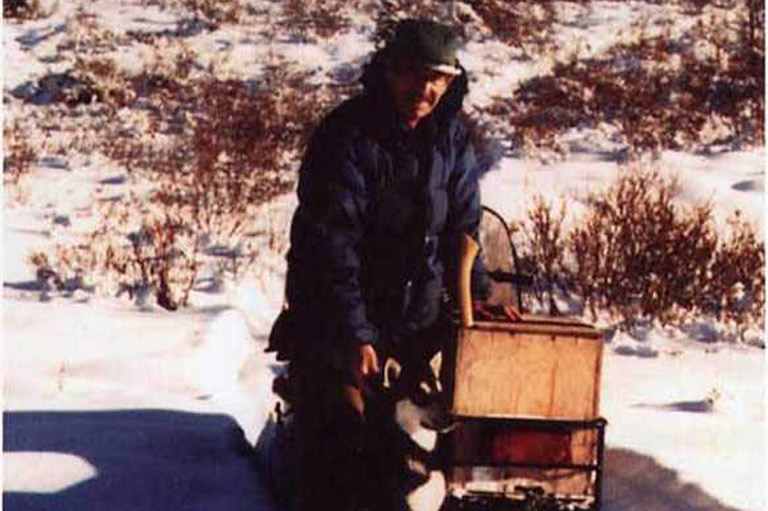 Gordon Toole on the trail in later life.
Gordon Toole on the trail in later life. -
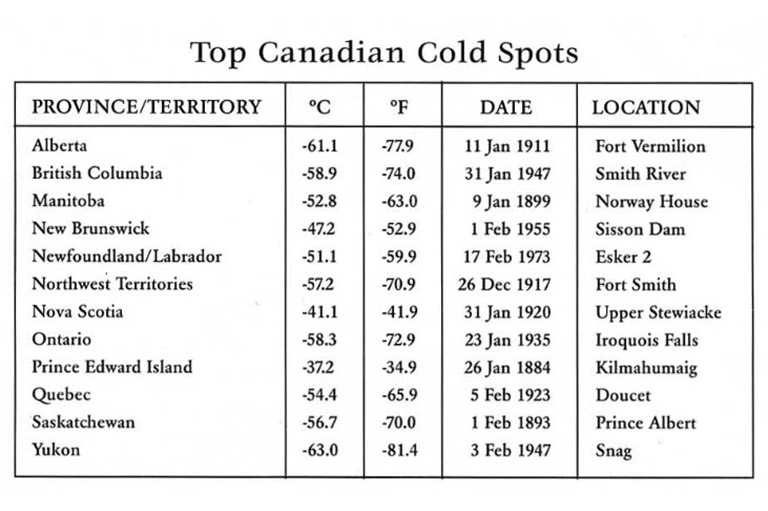 Top Canadian Cold Spots.
Top Canadian Cold Spots. -
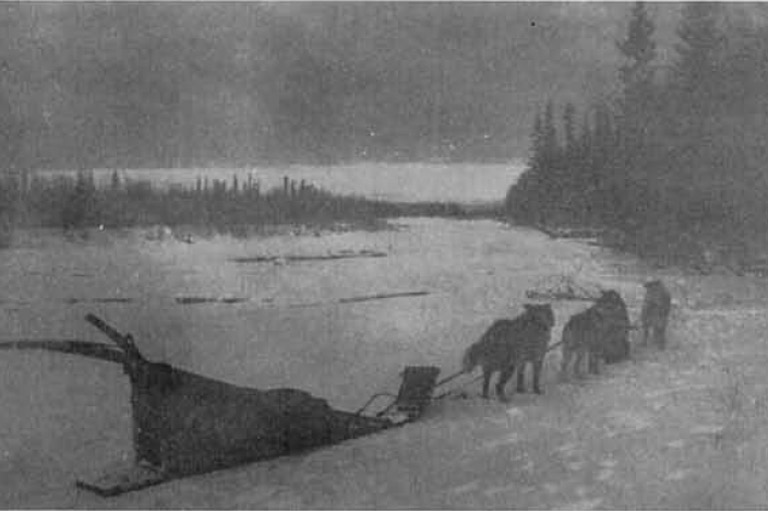 Toole's team benighted near Snag.
Toole's team benighted near Snag. -
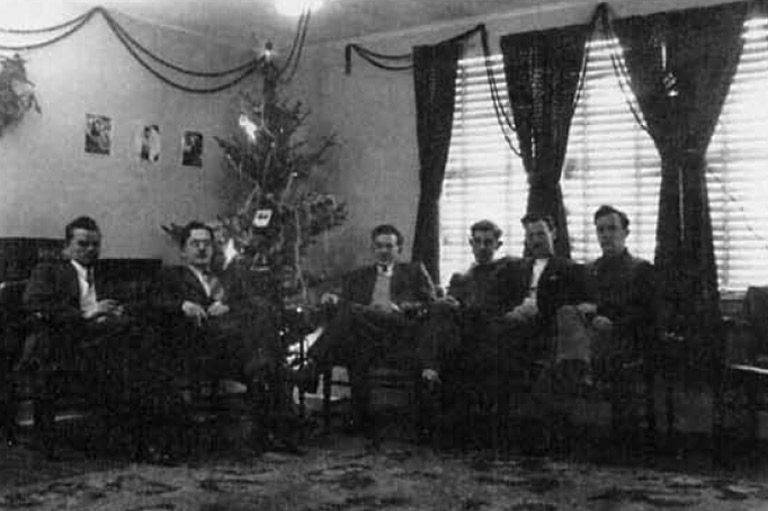
-
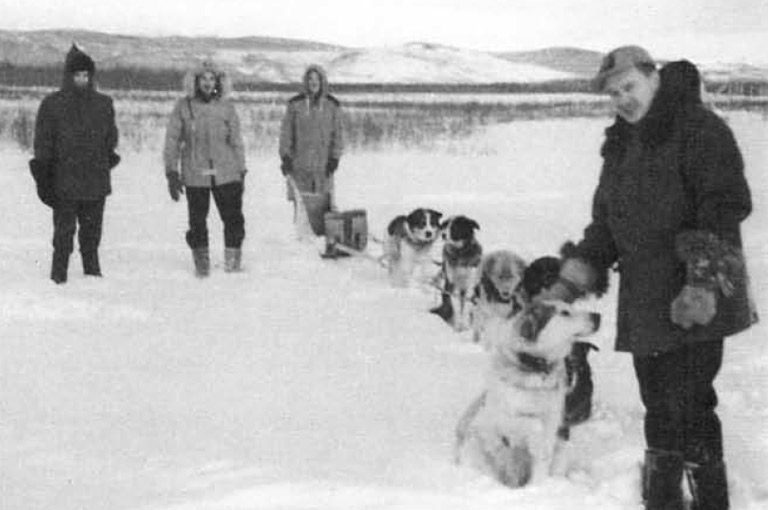 Weathermen near Snag airport, February 1947.
Weathermen near Snag airport, February 1947. -
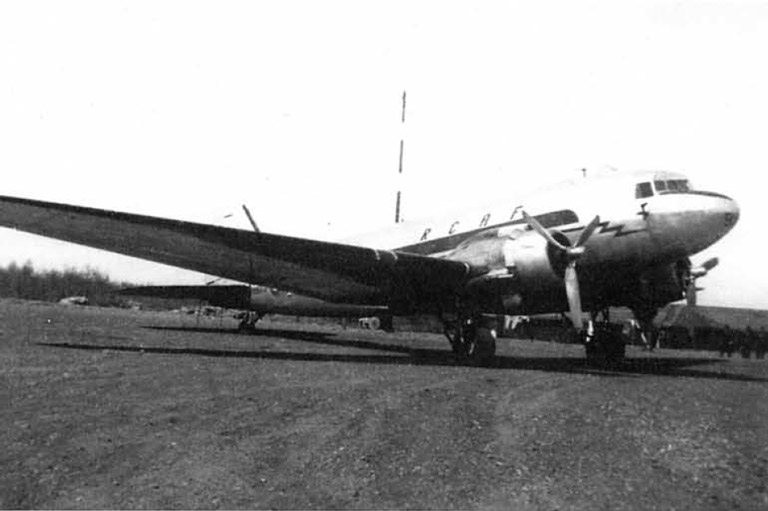 RCAF plane at Snag airport; a link to "outside."
RCAF plane at Snag airport; a link to "outside." -
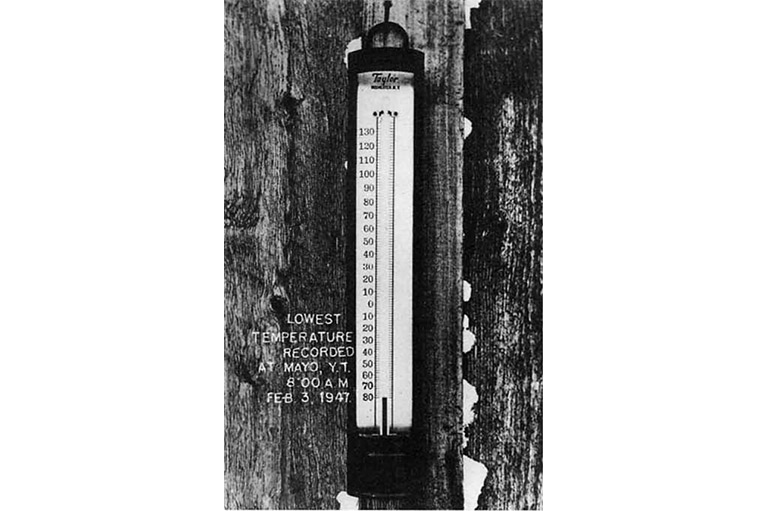 Photographic proof, taken at Mayo, 3 February 1947.G.A. McIntyre, Mayo
Photographic proof, taken at Mayo, 3 February 1947.G.A. McIntyre, Mayo
On 3 February 1947 at 7:20 A.M. Yukon time, weather observer Gordon Toole hurried the 30 metres from the warm, log barracks at Snag Airport, Yukon, to the weather instrument compound next to the runway.
For eight straight days the temperature had been below -58°F (-50°C), but on this morning it felt colder. Toole could plainly hear the dogs barking in the village, six kilometres to the north, and his exhaled breath made a tinkling sound as it fell to the ground in a white powder.
His six husky dogs were really feeling the cold. On this morning, they were asleep on top of their kennels, curled up with their noses tucked right up under their tails to gamer every calorie of heat.
With 7 uniquely curated newsletters to choose from, we have something for everyone.
By the time he arrived at the white louvered shelter housing the thermometers, he could feel the cold seeping through his parka. He unlatched the door of the instrument shelter, and shone the flashlight inside, but was careful not to lean forward and breathe on the thermometers.
From the corner of his eye, he saw something that he had never seen before. The tiny sliding scale inside the glass thermometer column had fallen into the bulb at the end, well below the -80°F (-62.2°C) point — the last mark on the thermometer.
Toole rushed back to the barracks where he coaxed his colleague, Wilf Blezard, to return to the instrument compound. Pointing a set of dividers on one end of the tiny bit of alcohol left in the column, Toole estimated the temperature to be about -83°F (-63.8°C).
As he dutifully scratched a mark on the outside of the thermometer sheath adjacent to the end of the alcohol, he thought about what head office had advised three days earlier. If the alcohol level ever fell below -80°F (-62.2°C), they should mark a corresponding point on the thermometer sheath with a pen.
Typical advice from Toronto, Toole thought. Ink does not flow at that temperature. Instead he made the historic mark using a fine, sharp file.
Advertisement
To complete the job, the observers noted that the weather was a repeat of the last two months — clear, dry and calm. Snow on the ground amounted to 38 centimetres, but was evaporating at three centimetres a day. The visibility at eye-level was 30 kilometres; however, on this day, ground visibility was greatly reduced. At about arm’s length, an eerie, dull-grey shroud of patchy ice or frost fog hung above the dogs and heated buildings.
Back inside the Snag weather office, the Department of Transport radio operator transmitted the weather observation to Whitehorse and Toronto. Within the hour, the Director of the Canadian Weather Service congratulated Snag on becoming North America’s “cold pole.”
He also asked Toole to send the thermometer back to be re-calibrated. The two observers shared the news with the rest of the camp, before packing the thermometer for air shipment to Toronto to have the readings confirmed.
But it was so cold that almost a week passed before it would be warm enough for an airplane to land at Snag. Once in Toronto, the thermometer was put through several laboratory tests before technicians concluded that it had been reading about 1.6°F in error.
Three months later, the weather service accepted a value of -81.4°F (-63°C) as the corrected temperature — still the lowest official temperature ever recorded in North America. It is a record that still stands today — 50 years later [editor’s note: In 2019, the record still stands, 72 years later].
Save as much as 40% off the cover price! 4 issues per year as low as $29.95. Available in print and digital. Tariff-exempt!
At Snag that day, all 16 men did not need confirmation in Toronto. They could feel how cold it was. But still they were excited by the news. Blezard, now retired and living in Grande Prairie, Alberta, recalls:
“We had to put a little lock on the door to the instrument screen because everybody was rushing out and looking at the thermometers. Even the slightest bit of body heat would cause the alcohol to jump.”
Fifty years is a long time ago, so perhaps it is not surprising that Toole’s memories of the day are different. “Staff interest,” he said, “was pretty limited. There was no euphoria, prolonged celebrating or serious discussion on how to commemorate the moment.”
Perhaps no one understood the historic significance or maybe it was just that the cold showed no sign of abating. But that was to change.
To start, by 2 p.m., the day’s high reached a relatively balmy -54°F (-47.7°C). Before the day was over, media from around the world had besieged the “frozen chosen” for exclusive interviews on the historic cold. Writers from the Milwaukee Journal and Vancouver Sun phoned for front-page stories to learn what -80 °F (-62.2°C) felt like.
The Globe and Mail reported the following headline: “Snag snug as mercury [sic] sags to a record -82.6°”. The thermometers did not use mercury because it freezes at -39°F (-39.4°C). They were alcohol thermometers and the newspaper knew it. Later in the story: “the only reason the men didn’t celebrate was that all the alcohol at the station was in the thermometer and that was nearly frozen.”
Telegrams of congratulations arrived from many countries. Several messages referred to the world’s new cold pole. But some expressed skepticism. For British meteorologists, who used to measure coldness in degrees of frost [below 32°F (0°C)], upwards of 115 degrees of frost was just too much to comprehend.
On 8 February, a plane arrived at Snag with American military and media who wanted to learn what it was like living and working in such cold conditions. The men at Snag, however, were more interested in the visitors’ cargo of meat, beer and whisky than in becoming celebrities.
Why is the lowest temperature record one of the best-remembered Canadian weather records? First, it was for that typically Canadian feature: cold. Second, it was the record for the western world. And finally, the short, odd name, “Snag”, made this legend of frigidity live on.
Snag was named during the Klondike gold rush. Because boatmen could not read the silty waters of nearby stretches of the White River and its tributaries, boats had to be poled upstream. On occasion, they would be “snagged” and punctured by sharp pointed tree trunks submerged below the milky waters, hence the name.
The Snag weather station operated from 1943 to 1966. It was located at the Snag Airport, east of the Alaska-Yukon boundary, and 25 kilometres north of the Alaska Highway at Mile 1178. The airport was at co-ordinates 62°23’N and 140°23’W, with an elevation of 646 metres.
Set in a broad bowl-shaped, north-south valley of the White River, a tributary of the Yukon River, the now-abandoned airport was surrounded by unglaciated uplands of moderate relief. The vegetation was mostly scrub and poplar trees of about three to six metres tall. The magnificent St. Elias mountains lay 50 kilometres to the south. The village of Snag was six kilometres to the north of the airport, near the point where the Snag Creek flowed into the White River. The village’s population of eight or ten Native people and fur traders was smaller than the staff at the airport.
Of the sixteen staff members at Snag airport, four single men in their early twenties were there to observe the weather. Toole was the officer-in-charge of the weather station. Meteorological staff earned about $1,320 annually, with an extra $20 monthly isolation allowance, which covered the room rate in the barracks. The daily food charge was 50 cents.
The other airport employees were radio operators, also employed by the Department of Transport, and airport maintenance and operations personnel, employed by the Royal Canadian Air Force, whose main job was to keep the runway open. Incidentally, in winter this meant compacting the snow, not ploughing or blowing the strip bare.
Snag was part of the Northwest Staging Route — one of several emergency landing strips or observing stations through Northwest Canada to connect Alaska and Yukon with Central Canada and the United States. They were set up in 1942 and 1943 to provide basic weather services for the RCAF, the United States Army Air Force, and for civilian aviation companies providing military transport. Most pilots flying the northwest route had to fly with visual contact with the ground, called visual flight rules (VFR); otherwise, they might get lost. If weather socked in the main airports, the pilots used alternate airports like Snag and Smith River.
The continental climate in this part of Yukon resembles that of eastern Siberia. Yearly precipitation averages 339 millimetres, with nearly two-thirds of that falling between May and September. The average yearly snowfall totals 155 centimetres. Winds are light with, in winter, a large percentage of calms. Temperatures are more variable with prolonged cold winters and warm summers. The January average daytime high is -13.2°F (-25.1°C) and the average night-time low -32.1°F (-35.6°C); while comparable July averages are high 69.6°F (20.8°C) and low 44.6°F (7°C).
The winter of 1946–47 had been exceptionally cold in the Canadian Northwest. At Snag, temperatures dipped below -58°F (-50°C) on six days in December, and on eleven days in January. From 27 January to 5 February, temperatures remained below -67°F (-55°C). On 30 January, the temperature fell to -76°F (-60°C), giving Yukon its coldest day ever, and Canada, its lowest in 38 years. On 2 February, the temperature fell to -80°F (-62.2°C), which was a new all-time Canadian record cold. But it was to last only a day: the very next day, the corrected temperature was -81.4°F (-63°C) — a new record low for all of North America.
The cold was not confined to Snag. Temperatures reached their lowest point between 1 and 3 February throughout the Yukon. Among the coldest sites were Aishihik Airport, -70.1°F (-56.7°C); Dawson City, -72.9°F (-58.2°C); Haines Junction, -63.0°F (-52.7°C); Kluane Lake, -56.0°F (-48.8°C); Teslin, -52.1°F (-46.7°C); Watson Lake, -67.0°F (-55°C); and Whitehorse, -59.1°F (-50.6°C).
There may have been more. On 3 February, the thermometer at Fort Selkirk, a very small community on the Yukon River, 180 kilometres east-northeast of Snag, recorded -85°F (-65°C), (corrected for instrument error). This reading, however, was not considered official because the thermometer was exposed on the outside wall of a building and not housed in the standard instrument shelter.
That same day at Mayo — a station about 300 kilometres northeast of Snag — the temperature apparently reached -80°F (-62.2°C). “Apparently” because at midnight on 15 February, the station burned down, destroying the weather instruments and observation records. However, photographic evidence exists which shows Mayo’s temperature reading on that day, about -80°F, which is just marginally above the Snag low.
Long-time resident and local booster, Jean Gordon, claims that while Snag may have a lower temperature extreme, Mayo, with its two schools, hotels and population of 500 people, can boast being the coldest “decent-sized” community in North America and, as a road sign entering Mayo claims, the town with the largest temperature range: a huge 177 degrees, from a maximum of 97°F (-36.1°C) to a minimum of -80°F (-62.2°C).
How did such cold happen? As in most Arctic cold spells, weather conditions in 1946–47 were favourable for a steep temperature inversion. Inversions, a frequent feature of arctic winters, are exceptions to the general rule that temperature decreases with increasing altitude. Inversions can be produced by gravitational drainage of cold air or by radiation. In elevated terrain, the heavy, dense air sinks and slides down the mountain slopes, often pushing any warmer air aloft. The ground also grows colder by radiating heat to the cloud-free sky. In doing so, the ground readily cools the air immediately above it, especially when the skies are clear, there is unlimited visibility, and the winds are calm or light. A layer of air closest to the ground may be as much as 20° to 40° colder than the air at 1,000 metres.
In 1946–47, a strong westerly circulation across North America confined cold arctic air over Alaska and northwestern Canada for much of the winter. During this time, the cold dome of heavy, dense air over the Yukon intensified. With a continuous supply of cold air from northeastern Siberia, the cold dome over the Yukon grew in extent and severity, creating all the record lows. But a dramatic change was to occur later in February: the westerlies relaxed, the cold air spilled through to eastern North America, resulting in severe cold as far south as Florida, and brought maritime air from the Pacific to the southern Yukon where the cold broke for a few days. At Snag, the mercury even rose to a more civilized plus 45°F (-7.2°C).
How did -81.4°F (-63°C) feel? Most Canadians never experience temperatures lower than -50°F (-45.5°C). Blezard and Toole repeatedly said there was a considerable difference between -50°F (-45.5°C) and -80°F (-62.2°C).
The following anecdotes, pieced together from station correspondence with the regional office in Edmonton that winter, as well as from recent interviews with the two observers, give us a glimpse of what life was like for the frozen 16 at Snag during the winter of 1946–47. Says Blezard:
“At 80°F (-62.2°C) below,... talking... and barking of dogs in the village could be plainly heard at the Airport four miles away. An aircraft that flew over Snag that day at 10,000 feet was first heard when over 20 miles away; and later, when overhead, still at 10,000 feet, the engine roar was deafening. It woke everyone who was sleeping at the time; because they thought the airplane was landing at the airport.”
Advertisement
Anyone who has ever skated outside or gone for long walks in the dead of winter knows that sound carries far and clear the colder it gets. That is because, ordinarily, sound spreads obliquely upward over our heads and is therefore not heard very far away. But, in very cold, stable air, the inversion bends the sound waves back toward the earth where they tend to hug the ground. Further, audibility is improved by the absence of turbulence or wind. In the end, conversations usually heard 30 metres away can be heard more than a kilometre away if the air is clear.
There are even more extraordinary sounds: for instance, when outside, staff at Snag could not only see, but hear, their moist breath solidify to ice in a hissing or faint swishing sound. From his home in Watson Lake, Yukon, Toole recalled the experience:
“It was unique to see a vapour trail several hundred yards long pursuing one as he moved about outside. Becoming lost was of no concern. As an observer walked along the runway, each breath remained as a tiny, motionless mist behind him at head level. These patches of human breath fog remained in the still air for three to four minutes, before fading away. One observer even found such a trail still marking his path when he returned along the same path 15 minutes later.”
There were other cold-weather experiences mentioned by the observers at Snag. For days, a small fog or steam patch would appear over the sled dogs, at a height of 15 to 20 feet. It would disappear only in the warm part of the day when the temperature warmed up to 60 below. A piece of thin ice, when broken, sounded exactly like breaking glass; and a chunk of ice was so cold that, when brought into a warm room, it took five full minutes before there was any trace of moisture, even when held in the hand.
Blezard recalls antics around the camp during the cold spell:
“We threw a dish of water high into the air, just to see what would happen. Before it hit the ground, it made a hissing noise, froze and fell as tiny round pellets of ice the size of wheat kernels. Spit also froze before hitting the ground. Ice became so hard the axe rebounded from it. At such temperatures, metal snapped like ice; wood became petrified, and rubber was just like cement. The dog’s leather harness couldn’t bend or it would break.”
Toole added a few of his memories of sounds and nature during the cold snap:
“Ice in the White River about a mile east of the airport, cracked and boomed loudly, like gun fire. During the bitter cold, you would go days without seeing any wildlife, apart from ravens, rabbits, mice, snowbirds and ptarmigans. Cold air generated intense radio static much like the crackling during a thunderstorm.”
Life in the cold had its complications. Surprisingly, heating the log buildings was less of a problem that one might expect. In a memo to his superior, Dr. Tom How, officer-in-charge of the Edmonton forecast office, Toole wrote about the hardships that winter:
“With constant stoking of the furnace the temperature of the barracks remained quite comfortable. The only uncomfortably cool room in the barracks was the common room, this was due to a large hole, 8 feet by 4 feet, being in the ceiling. The hole was caused by the freezing and bursting of one of the water pipes on December 2nd. Despite promises by the RCAF at Whitehorse that a carpenter was coming up on the first available aircraft to fix the ceiling, the temporary patch, put on by two of the radio personnel and myself, remains.”
Toole wrote further:
”No provisions have been made for supplying the barracks with water for drinking or washing purposes. This, as you can see, has made it almost impossible for personnel to wash more than once a day and has terminated showers or baths. ... After seconds outdoors, nose hairs freeze rigidly and your eyes tear. Facial hair and glasses become thickly crusted with frozen breath ... you had to be careful not to inhale too deeply for fear of freezing or scalding one’s lungs. The only other discomfort caused by the cold were numerous cases of beginning frostbite, particularly the familiar ‘ping’ as the tip of one’s nose froze. One only had to remain outside for 3 or 4 minutes with face exposed before cheeks, nose and ears were frozen.”
During the extreme cold, outdoor chores had to be postponed. The weather staff felt fortunate that observing duties kept them outside only for two minutes every hour. On the other hand, the enlisted men were outside for relatively long bouts, hauling wood to keep the barracks, the garage and powerhouse warm. They had to take extra precautions to prevent throat and lung burn from over-exertion in the frigid air. Says Blezard, “It was easy to freeze your nose at -70°F (-56.6°C) without even knowing it was cold. At -30°F (-34.4°C) you feel it coming”.
Beating the “cold blues” was another challenge. Toole busied himself during the cold spell by checking his trap lines; others played cards, boxed, listened to classical music, read and talked. And the talk was about the wretched cold.
In the midst of the cold spell, there was no re-supply by RCAF planes from Whitehorse for several weeks. Blezard recalled: “All we ate was fish and bacon and eggs... there was very little meat ... we lived mostly on beans for the last five days.”
Starting machinery was also a chore. And, getting an engine started was no guarantee it could continue to run. At that temperature, the oil and the transmission fluid coagulated into something approaching a solid. Also, truck tires could splay open when they hit ruts. But the weather instruments, apart from the thermometers, all seemed to work in the cold.
How does the Snag record stand compared with the rest of the world? Being the North American record, it beats every official temperature reading in Canada and in the United States.
The Snag record beat the previous lowest Canadian temperature of -77.9°F (-61°C), recorded on 11 January 1911 at Fort Vermilion, Alberta (still Western Canada’s lowest official temperature, though), as well as the lowest temperature ever recorded in the United States. That was -79.8°F (-62.1°C) recorded on 23 January 1971 at Prospect Creek, Alaska, a camp along the Alaskan pipeline in the Endicott Mountains.
For comparison, the table on page 33 shows official record low temperatures for the Canadian provinces and territories. Interestingly, in the Arctic Islands, the lowest temperature ever reported was -69.2°F (-56.2°C) at Lake Hazen, a special International Geophysical Year observing station, on 4 January 1958.
Unofficially, however, temperatures lower than -81°F (-62.7°C) have been reported. On 7 January 1982, two temporary sites near Fort Nelson, in northeastern British Columbia, reported temperatures of -96°F (-71.1°C) and -92°F (-68.8°C), in connection with a permafrost study; while the temperature at Fort Nelson airport weather station was -43.6°F (-42°C). The extreme temperatures were attributed to intense cold air in mountain valleys during a long, cold, clear night.
Will Snag remain North America’s cold spot? Only time will tell. But one thing is for certain, weather observers will no longer have to mark thermometer sheaths when temperatures fall below -80°F (-62.2°C). Now, all official alcohol thermometers in Canada have markings to -94°F (-70°C), a thermometer redesign due to the coldest day in Canadian history.
At Canada’s History, we highlight our nation’s past by telling stories that illuminate the people, places, and events that unite us as Canadians, while understanding that diverse past experiences can shape multiple perceptions of our history.
Canada’s History is a registered charity. Generous contributions from readers like you help us explore and celebrate Canada’s diverse stories and make them accessible to all through our free online content.
Please donate to Canada’s History today. Thank you!
Themes associated with this article
Advertisement

